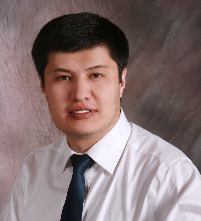| Topic(s): Proteomics > Pre-Analytics |
|
Poster Presentation Poster #9a Attended on Thursday at 11:00
|

|
|
|
|

|
Jikyo Lee (Presenter) Seoul National University Hospital
|
| Introduction: Recently, matrix-assisted laser desorption/ionization time-of-flight mass spectrometry (MALDI-TOF MS) has emerged as a sensitive method to detect small amounts of M-protein. Dominantly, IgG is the most common type of monoclonal protein (M-protein) observed in patients with plasma cell disorders (PCDs). There are various techniques for IgG purification, such as Melon™ gel IgG spin purification kit, magnetic beads consist of protein G, and IgG affinity beads. We compared those three methods to find the most effective IgG purification approach for detecting M protein. Objectives: We sought to find out the most effective method to purify IgG for detecting M-protein by MALDI-TOF MS. Methods: A normal and an abnormal patient’s serum samples were selected from residual samples from immunofixation electrophoresis (IFE) tests on HYDRASIS 2 (Sebia, Fulda, German). In the IFE result, a patient serum showed IgG and kappa type of monoclonal antibody. To observe analytical sensitivity, daratumuamb was serially diluted into a normal serum at concentration of 0, 0.05, 0.1, 0.2, 0.5, 1.0 g/dL. C4 ZIPTIP was used for desalting after Melon™ Gel IgG Spin Purification Kit (Thermo Fisher Scientific Inc., MA, USA). For beads based methods, Dynabeads™ magnetic beads (Thermo Fisher Scientific Inc., MA, USA) and CaptureSelect™ affinity beads (Thermo Fisher Scientific Inc., MA, USA) were used. For each purification method, samples were spotted five times onto a 96-well plate. Each set of replicates was measured by MALDI-TOF MS (Bruker Daltonics, Bremen, Germany) for five days. We used α-Cyano-4-hydroxycinnamic acid (CHCA) matrix, and 500 shots were summed up. Results: Peaks indicating reduced light chains with single and double charge of purified IgG were observed in mass spectrum within the 22000-23000 and 11000-12500 range of mass-to-charge ratio (m/z), respectively. Polyclonal peak consisting of kappa light chain and lambda light chain was observed in normal patient, while monoclonal peak was observed with higher intensity in abnormal patient. Coefficients of variation of m/z values for all the methods were in less than 20%. Limit of detection of IgG affinity beads was 0.1 g/dL, which was the lowest among three methods. Melon kit with C4 ZIPTIP was 0.2 g/dL, and magnetic beads showed 0.5 g/dL. IgG purification using CaptureSelect™ affinity beads showed a superior outcome compared to Melon kit or magnetic beads for detection of monoclonal protein. Melon kit might be considered as an alternative method for IgG Purification. Conclusions: Among three methods, IgG affinity beads showed the best outcome to purify IgG for identifying M-protein using MALDI-TOF MS. |
| Topic(s): Assays Leveraging MS > Proteomics > Emerging Technologies |
|
Poster Presentation Poster #18a Attended on Wednesday at 11:00
|

|
|
|
|

|
Sebastian van den Wildenberg (Presenter)  Eindhoven University of Technology
|
| Introduction: LC-MS methods using bottom-up based and/or middle-down have been popular methods for the quantification of proteins. However, the development of these methods often come with extensive sample preparation that require thorough assay optimization. In addition to this using bottom-up proteomics sequence coverage is often limited and information about Post Translational Modification’s (PTMs) is lost. Using top-down proteomics intact protein are analyzed, without digestion, reducing sample preparation and retaining the maximum amount of information. Top-down proteomic approaches have their own specific challenges, such as limited sensitivity and the availability of internal standards and reference material. Objectives: The primary objective of this study is the development of an immunoprecipitation assay, followed by intact top-down protein analysis using LC-QToF-MS for the quantification of the small cell lung cancer (SCLC) tumor biomarker Neuron Specific Enolase (NSE). Methods: Immunoprecipitation was performed by coupling Protein-G-labeled magnetic Dynabeads™ to monoclonal antibodies against NSE. The protein-G-antibody complex was crosslinked with BS(PEG)5. Human (NSE-spiked) serum was incubated with antibody coupled beads. After incubation, the beads were collected using a magnet and serum was removed. Collected beads were washed and the captured NSE proteins were eluted from the beads. The eluted proteins were separated using RP-LC and analyzed by QToF-MS. Results: The immunoprecipitation method was developed and optimized for the isolation of NSE. Protein elution from the antibody-antigen-complex was conducted using water-acetonitrile (80:20) + 1% formic acid. Using this method recombinant NSE was successfully isolated from spiked human serum. Adequate linearity and sensitivity were achieved in the clinically relevant concentration range of 0 to 100 ng/mL using both QToF-Full Scan MS + Extracted Ion Chromatogram (XIC) and QToF-Selected Reaction Monitoring. Conclusion and Outlook: An immunoprecipitation method couple to a LC-QoF-MS method was developed and optimized for the isolation and quantification of recombinant NSE from spiked human serum. Next steps will focus on the isolation of endogenous human NSE from serum and optimization of the chromatography by transferring the method from UPLC to nano-LC. Additionally, QToF-MS- methods and data collection modes that can be used are compared, such as mass deconvolution, single reaction monitoring (precursor > product), pseudo-single reaction monitoring (precursor > precursor), extracted ion chromatograms and combinations. |
| Topic(s): Imaging > Emerging Technologies > none |
|
Poster Presentation Poster #25b Attended on Thursday at 12:30
|

|
|
|
|

|
Behnaz Akbari (Presenter)  Boston University
|
| Introduction Advanced mass spectrometry (MS) has broadly grown in tissue sample analysis, namely, imaging mass spectrometry (IMS), imaging mass cytometry (IMC), high-throughput analysis of tissue microarrays using automated desorption electrospray ionization mass spectrometry (DESI-MS), MasSpec pen, intelligent knife (iKnife), Laser Desorption Probes (Handheld probes), and topography molecular imaging with the assistance of a robotic arm coupled with water-assisted laser desorption (SpiderMass). However, intraoperative applications of MS require to be introduced as routine techniques for pathologists to improve patient healthcare and to extend the assessment of decision-making skills for surgeons. Objectives The bold ambition is to promote MS to the broader clinical community, integrating with quantitative multimodal imaging to visualize the data hidden in tissue samples. Because in a clinical setting, the primary concern is to analyze thin tissue sections from patients after sample preparation which could negatively affect sensitivity analysis of assurance methods and imaging quality. This is so we can link IMS and or IMC techniques to other imaging platforms, allowing interactions with pathologists, image analysis scientists, and surgeons in biomarker discovery, immuno-oncology, neuroscience, and metabolism. Methods Outline an IMS infographic, integrating imaging tools such as HALO and SciLS Lab, providing an understanding of quantitative multimodal imaging with simultaneous histological assessment. Results The infographic IMS project incorporated educational technology and engaged the multi-disciplinary team (chemists, pathologists, and surgeons) in clinical laboratories. Several beneficial features, such as a quick overview of IMS technology in the clinical setting and multimodal imaging integration, could promote visual literacy and develop creativity in the imaging domain.
Conclusion The infographic IMS project helps clinicians understand the world of multimodal imaging workflows for later use at the operating suite housed in a hospital to aid pathologists and surgeons in exploring emerging questions in immunology, neuroscience, and cancer. |
| Topic(s): Pre-Analytics > Assays Leveraging MS |
|
Poster Presentation Poster #27b Attended on Thursday at 12:30
|

|
|
|
|
|
Dahai Shao (Presenter) The Cleveland Clinic Foundation
|
|
| INTRODUCTION: Blood acylcarnitine profile analysis is a powerful tool to diagnose numerous inherited metabolic disorders, including many mitochondrial fatty acid oxidation disorders and organic acidemias. It is used for follow-up testing of screen positive results from newborn screening programs and in the evaluation of children and adults suspected of having a fatty acid or organic acid disorder. Serum or plasma samples, the latter obtained with a variety of anticoagulants, are normally accepted for acylcarnitine profile analysis. In view of the diverse types of blood collection tubes used in acylcarnitine analyses, it is important to evaluate possible matrix effects on the measurement of the many acylcarnitines that are assessed in blood acylcarnitine assays. METHODS: More than 50 acylcarnitines and related analytes were measured by liquid chromatography-tandem mass spectrometry using plasma obtained from sodium heparin (green top tube), lithium heparin (green top tube), and EDTA (lavender top tube) anticoagulated tubes, as well as serum (red top tube). Samples from each blood tube type were obtained at the same time from three healthy individuals. RESULTS: Several analytes showed significant (>30%) matrix effects. Among them, butyrobetaine was ~30-75% higher in heparinized plasma than in serum or EDTA anticoagulated plasma. Propionylcarnitine (C3) was about 35% lower when measured in serum than in all plasma tube types. CONCLUSIONS: When differences of acylcarnitine concentrations between serum and plasma tubes straddle medical decision cut-offs, diagnostic decisions can be impacted; this may be particularly relevant for mild and late-onset forms of inherited metabolic disorders. These data suggest the utility of using matrix-specific reference intervals for those analytes that differ significantly between tube types. |
| Topic(s): Proteomics > Multi-omics |
|
Poster Presentation Poster #42a Attended on Wednesday at 11:00
|

|
|
|
|

|
Hammam Said (Presenter) Dalhousie University
|
| Introduction: Membrane proteins have multiple critical physiological roles including signal transduction, membrane trafficking, subcellular compartmentalization, and protein secretion. These functions lend membrane proteins as attractive targets for drug therapeutics. Despite their clinical significance, membrane proteins are notoriously underrepresented in proteomics workflows due to their poor solubility. To improve the solubility of membrane proteins, previous groups have employed mass spectrometry (MS) compatible surfactant, as well as methanol (60%). Despite these approaches, sodium dodecyl sulfate (SDS) is still favored for the solubilization of membrane proteins. The addition of SDS however is known to impose challenges in downstream processing, as it deteriorates reverse-phase separation and suppresses MS ionization. Our group has developed an electrophoretic approach known as transmembrane electrophoresis (TME) to deplete SDS while maintaining a high protein yield (>95%) in 5 minutes 1,2.
Objectives: The current project employs a solvent system tailored to membrane proteins to accelerate SDS depletion while maintaining the higher solubility of hydrophobic proteins. Method: Methanol and SDS were added to an S. cerevisiae membrane proteome extract in varying quantities. Samples were then depleted of SDS in a custom-built TME device 2. BCA assay was used to quantify proteins recovered after a TME run, while MBAS assay was used to quantify the residual SDS in the sample. SDS PAGE was also used to further verify the quantity of proteins recovered. Samples were then subjected to an orbitrap MS for profiling. The resultant spectrum was searched against a uniport database for protein count and identification. Results: BCA assay, SDS PAGE, and MS results have suggested that the inclusion of 40% methanol improved protein recovery. Increasing the methanol concentration beyond 40% caused a reduction in the recovery. Measurement of residual SDS in the sample using an MBAS assay after a TME run showed that the higher the methanol concentration the higher the rate of SDS depletion. Lastly, 223 hydrophobic proteins have been identified in the 40% methanol that was not present in 0% methanol, 192 of which are membrane proteins of the cell and mitochondria. Conclusion: The inclusion of 40% methanol has increased the SDS depletion rate in the TME along with higher recovery of membrane proteins. References 1- Kachuk, C.; Doucette, A. A. J. Proteomics 2018, 175, 75−86. 2- Jakubec, P.; Doucette, A. Automated Electrokinetic Platform for High-Throughput Sodium Dodecyl Sulfate Depletion Ahead of Proteome Analysis by Mass Spectrometry. Anal. Chem. 2021, 93(42), 14042–14047. |
| Topic(s): Tox / TDM / Endocrine |
|
Poster Presentation Poster #50a Attended on Wednesday at 11:00
|

|
|
|
|

|
Shelby Hutcherson (Presenter)  Memorial Sloan Kettering Cancer Center
|
| Introduction: Prior to hematopoietic stem cell transplantation (HSCT), a conditioning regimen consisting of high doses of one or more myeloablative agents is given to most patients. This serves to both prevent rejection of the transplanted stem cells and reduce the tumor burden in patients with hematological malignancies. However, myeloablative agents can also cause serious and sometimes irreversible side effects. Treosulfan (Treo) is a structural analog of the alkylating agent busulfan which has been shown in clinical trials to have an improved safety profile compared to busulfan while still maintaining comparable myeloablative activity. Unlike busulfan, Treo is a prodrug which undergoes a pH- and temperature-dependent, nonenzymatic, sequential conversion into two epoxide species with alkylating activity. Because plasma concentrations of Treo exhibit significant interindividual variability, therapeutic drug monitoring (TDM) is necessary to ensure dosages are given that maximize efficacy while minimizing toxicity. Treo is currently being considered for approval by the FDA in combination with fludarabine (Flu) as a conditioning regimen prior to allogeneic HSCT and is also currently being evaluated in combination with Flu and/or other agents in several clinical trials in the United States. As the use of Treo increases in clinical trials and eventually in routine clinical practice, it will be important to be able to quantitate it rapidly and accurately in the clinical laboratory. Objective: The objective of this study was to develop an accurate liquid chromatography-tandem mass spectrometry (LC-MS/MS) assay capable of simultaneously quantifying Treo and Flu in plasma across a wide range of concentrations in order to facilitate TDM of both compounds. Methods: Deuterated Treo (Treo-d4) and Flu-C13N15 were used as the internal standards (IS) for Treo and Flu, respectively. To prevent the degradation of Treo into the epoxide species, 1 M citric acid was added to all plasma used for validation studies (50 μL per 1 mL of plasma). Drugs were extracted from 100 μL of acidified plasma via protein precipitation with methanol containing IS. After centrifugation at 13,000 rpm for 10 min., 10 μL of the supernatant was injected into the liquid chromatography system and subjected to chromatographic separation followed by electrospray ionization (ESI) tandem mass spectrometry. Treo and Flu measurements were performed on a Thermo Scientific TLX-2 HPLC system coupled to a TSQ Quantum Ultra mass spectrometer in positive ion mode, and compounds were detected using multiple reaction monitoring (MRM) mode. MRM transitions were as follows: Treo 296.0 > 183.1 and 296.0 > 87.1 m/z; Flu 286.1 > 154.0 and 286.1 > 134.0 m/z. Drug concentrations were calculated using a six-point calibration curve. Accuracy was evaluated by spiking Treo and Flu into acidified blank plasma at three concentrations spanning each compound’s analytical measurement range (AMR) and calculating the percent recovery after performing LC-MS/MS. Inter-day imprecision was assessed at three concentrations spanning the AMRs by running an LC-MS/MS batch daily for 20 days and calculating the coefficient of variation (CV). To test for the presence of matrix effects, five waste patient plasma samples were acidified and extracted with methanol. Five calibration curves were prepared by spiking Treo and Flu into the plasma extract and five calibration curves were prepared by spiking Treo and Flu into methanol. The mean signal obtained for each compound from the calibration curves prepared in plasma extract after LC-MS/MS was then compared to the mean signal obtained for each compound from the calibration curves prepared in methanol. The stability of Treo at three concentrations spanning the AMR was determined by spiking Treo into acidified or non-acidified blank plasma and performing drug extraction and LC-MS/MS at regular intervals over the course of 24 hours. Results: Treo was stable at 4°C in acidified plasma for up to 12 hours but degraded rapidly in non-acidified plasma. Calibration curves for both Treo and Flu were linear over each drug’s AMR with R2 values exceeding 0.99. Recovery for both compounds ranged from 95-100% at all three concentrations tested. Similarly, inter-day imprecision was <10% for Treo and Flu at each of the three concentrations tested. Imprecision for Treo ranged from 1.5-9.0%, and imprecision for Flu ranged from 3.9-8.3%. The differences observed when comparing Treo and Flu signal in calibration curve samples prepared in plasma extract to signal obtained from calibration curve samples prepared in methanol were negligible, indicating that no matrix effects are present. Conclusion: Our LC-MS/MS method is able to simultaneously quantify Treo and Flu across a wide range of concentrations. Although the validation is ongoing, the assay exhibits acceptable accuracy, imprecision, and linearity, and it is not impacted by matrix effects. The relative instability of Treo and the necessity of acidifying plasma samples directly after collection presents important logistical considerations that will need to be taken into account when implementing Treo measurements clinically. This assay will enable simultaneous TDM of Treo and Flu when used in combination for conditioning prior to HSCT in clinical trials and routine clinical practice. |
| Topic(s): Microbiology > Lipidomics > Assays Leveraging MS |
|
Poster Presentation Poster #56a Attended on Wednesday at 11:00
|

|
|
|
|

|
Linda Nartey (Presenter) University of Victoria
|
| INTRODUCTION: Early detection of pathogens is essential for management of urinary tract infections (UTIs). Current tests require 2-3 days for culture and antimicrobial susceptibility tests for disease diagnosis. Protein analysis techniques have become the standard for clinical microbial identification, replacing phenotypic characterization and microscopic methods. These techniques are reliable, but require culture (24-48 hours) and are often labor-intensive, which increases the cost and burden of diagnostic laboratory support. A faster workflow that maintains accuracy of protein-based methods while reducing costs and time to identification is essential. OBJECTIVES: To use mass spectrometry (MS)-based phenotypic profiling of species-specific membrane lipids to accurately identify microbes directly from clinically specimen without culture. METHODS: Urine samples were collected from the Victoria general hospital and analyzed using our novel fast lipid analysis technique (FLAT). The FLAT method allows direct lipid extraction on a MALDI plate for pathogen identification by MALDI-TOF MS (Sorensen et al. Sci Repo 2020). Briefly, 1 µL of urine was spotted on an MFX µFocus MALDI plate. Acidified and incubated in a humidified chamber at 110°C for 30 min. The plate was rinsed with distilled water and then 1 µL of Norharmane (10mg/mL) was added to each spot. After drying, samples were analyzed using a Bruker Microflex in negative ion, linear mode with automated laser operation. Results were compared against the hospital’s standard protein biotyper identification. RESULTS: 302 urine samples were collected for this study. We identified clinically significant pathogens such as E. coli, P. aeruginosa, Proteus sp, Klebsiella sp and even as polymicrobial directly from 1 µL of urine. Overall, FLAT data produced a sensitivity of 94% and specificity of 99% with positive and negative predictive value of 93 and 99%, respectively for Gram-negatives. Two patients were found to harbor a mobile colistin resistance (mcr) gene as noted by chemical modifications to their lipid A by phosphoenthanolamine. These specimens were confirmed positive for mcr-1 by polymerase chain reaction. Additionally, ~ 40% of the negative samples showed an ion at 1446 m/z, which is reported to be the signature ion for P. aeruginosa lipid A. However, these samples containing this 1446 ion by FLAT failed to produce viable colonies when isolated on a culture plate. Tandem MS results of the 1446 ion confirmed it was a most likely a host cardiolipin (Kim et al. Journal of Lipid Research, 2011). Furthermore, FLAT detected an ion at m/z 1230 present in all urine samples with blood. Tandem MS results of this ion compared against a plasma standard analyzed by FLAT confirmed it was a heme dimer. CONCLUSIONS: UTIs are common infections that produce a substantial workload for a clinical microbiology laboratory. The ability to identify pathogens without need for culture allows for faster pathogen identification, reduced time to appropriate antimicrobial therapy, and improved patient outcomes. When compared to the hospital’s standard protein-based MALDI-TOF MS assay, FLAT produced accurate microbial identifications within one hour of receipt in the analytical laboratory. In addition, FLAT identified pathogens present in both mono- and poly-microbial infected UTI samples directly from specimen without culture. FLAT is an affordable, one-hour rapid test that has the potential to rule out suspected UTIs in the general population greatly reducing healthcare costs by circumventing the need for culturing negative samples. Finally, FLAT can be used to improve antimicrobial stewardship by detecting 1) UTIs negative for Gram negative pathogens circumventing the need for culture required for protein-based identification and 2) select antibiotic resistance markers, which is a major advantage of lipidomic-based microbial identification over standard protein-based methods currently used in the clinical laboratory. Our study is ongoing to optimize FLAT detection for Gram positives that have a worse limit of detection than Gram negatives. |
| Topic(s): Emerging Technologies > Tox / TDM / Endocrine > Various OTHER |
|
Poster Presentation Poster #59a Attended on Thursday at 11:00
|

|
|
|
|

|
Cody Orahoske (Presenter)  University of California San Francisco
|
| Introduction: Despite significant progress decreasing blood lead levels among US children 1-5 years of age, demonstrated by a 97.5th percentile of 3.5 µg/dl, lead poisoning remains a public health threat. Lead exposure disproportionately affects Black children, and those below poverty levels, in Medicaid, and living in housing units built before 1978. To improve public safety and testing compliance in children younger than 2 years of age, sample collection can be done by using filter paper and dried blood spots. These cards offer the advantage of easy handling and a less invasive collection method. Lead testing from the dried blood spot is comparable to the gold standard detection of lead from a venous whole blood samples although may be prone to contamination and other interferences. We describe a robust and reproducible test which can be used to measure lead from dried blood spots. Objective: The primary objective of this study was to develop a method using dried blood spot cards for lead testing using inductively coupled plasma-mass spectrometry (ICP-MS). Methods: This method was developed on a Thermo Fisher iCAP RQ and TQ ICP-MS (Thermo Fisher Scientific, Waltham, MA, USA) in kinetic energy discrimination (KED) mode. The method was calibrated with certified reference material traceable to NIST SRM 3128 (VHG labs, Manchester, NH, USA) in whole blood spotted in Whatman 903 cards at various concentrations and dried for at least two hours. Briefly, 5 ml of extraction buffer was added to a 6mm filter paper disc, followed by a 1-minute vortex at 2,000 RPM, incubation at room temperature for 30 minutes and centrifugation at 4,000 RPM for 5 minutes. Samples were loaded onto an Elemental Scientific Inc. (ESI, Omaha, NE, USA) SC-FSAT sample introduction system and subjected to analysis by the ICP-MS. To assess the performance of the method, the following characteristics were established: linearity, reproducibility, and accuracy. Accuracy and linearity across the measurement range were assessed using a reference standard solution traceable to NIST CRM 3128 (Inorganic Ventures, Christiansburg, VA, USA). Reproducibility and accuracy were assessed using used UTAK controls (Valencia, CA) and 16 patient samples with lead values obtained in a whole blood method. Results: The assay is linear across the analytical measurement range of 1 to 100 µg/dl, and recovery of the linearity materials ranged from 92% to 102%, with an average SD of ± 0.8 µg/dl. In 16 patient samples with concentrations ranging from 1.4 to 19.5 µg/dl run in six replicates, the coefficient of variation (CV) range was 0.6% to 21.1%. In these samples, the bias ranged from -4.4 µg/dl to 0.1 µg/dl. In controls recovery ranged from 88% to 100% and CV ranged from 2.6% to 6.0%. Finally, this method successfully quantified five proficiency testing samples from the Dried Blood Spot Lead Proficiency Testing Program (Wisconsin State Laboratory of Hygiene, University of Wisconsin, Madison, WI). Conclusion: The dried blood spot method was reproducible and comparable to the routine testing method in whole blood. This dried blood spot lead test meets the performance criteria to be validated as a clinical test in pediatric patients. |
| Topic(s): Proteomics > Precision Medicine |
|
Poster Presentation Poster #61b Attended on Thursday at 12:30
|

|
|
|
|

|
Oliver Slingsby (Presenter)  University of Leicester
|
| Introduction Type 2 diabetes (T2D) and heart failure (HF) are both growing in prevalence and concern with T2D patients at 2-fold increased risk of developing HF, regardless of other cardiovascular diseases. Protein biomarkers are routinely used as prognostic and diagnostic tools for disease however, in HF they lack specificity and sensitivity. Furthermore, they often vary in concentration within different ethnicities, ages, genders, or diseases. A main limitation of plasma for biomarker discovery is the high dynamic range limiting the detection of low abundant proteins. Therefore, emerging methods have been utilised to enrich low abundant proteins from plasma. The aim of this study is to identify protein biomarkers for the detection of HF in a T2D cohort based on subclinical myocardial changes. Methods Extracellular vesicles (EVs) were isolated through precipitation with acidic ammonium acetate and lysed. The unbound fraction was added to lipid removal agent (LRA) to bind for an hour. The following steps were done to both EV and LRA methods separately. Proteins were reduced and alkylated with DTT and IAA, and digested overnight with trypsin. Salts and impurities are removed through solid phase extraction and 250 ng was loaded onto the mass spectrometer for analysis. The sample was desalted and chromatographically focused by a Symmetry C18 Trap column before separation by an Acquity UPLC M-Class HSS T3 column. Separation occurred over 125 minutes using aqueous mobile phase A (0.1 % FA) and organic mobile phase B (80 % ACN, 0.1 % FA). Initial conditions were 97 % A this was held for 4 minutes followed by a linear gradient to 60 % A at 97 minutes. Residual proteins were washed off with 10 % A for 5 minutes then an isocratic hold at 97 % A for 17 minutes. The column was directly coupled to a Waters Synapt G2-S mass spectrometer (MS) by an electrospray ionisation source. The MS was operated in HDMSe positive ion mode with an ion mobility velocity of 326 m/s and wave height of 40 V. Low CID energy of 15 V was applied across the transfer ion guide. High CID energy used a ramped look up table. Argon was used as the CID gas. Data was acquired using MassLynx4.1 and data processed in Progenesis QI. Statistical analysis was performed using RStudio, where identified proteins were filtered for redundancy and low counts. Batch effects were removed using surrogate variables before the proteins were investigated for significant correlations to multiple models indicative of HF. These models were comprised of clinical imaging and exercise variables including, global longitudinal strain (GLS), average EE (EE), extracellular volume (ECV), and peak VO2 max (VO2). Further statistical analysis was undertaken using weighted correlation network analysis to identify modules of proteins associated with disease. Results A multivariate model was created to interrogate the relationship between expression levels of proteins and HF variables. Initial processing in Progenesis QI resulted in 3086 and 2247 proteins being identified in the EV and LRA datasets, respectively. After filtering, 2685 and 1874 proteins remained in the EV and LRA datasets, respectively. Each dataset was separately correlated against each variable and then underwent weighted correlation network analysis to identify significant proteins associated with each variable. The two datasets were then combined after statistical analysis. There were 238, 432, 530, and 360 proteins that were significantly associated with variable GLS, EE, ECV, and VO2, respectively. Comparing the lists identified 93 proteins that were common between all four variables of interest and these underwent protein-protein interaction (PPI) analysis to further reduce the number of significant proteins. Based on the PPI analysis proteins were filtered based on the number of interactions they shared. Any protein with less than 3 interactions was removed from the candidate list. Finally, the remaining proteins were filtered based on their original confidence score and the number of unique peptides identified, given by Progenesis QI. This resulted in a final list of 27 proteins to be verified and validated. Discussion The identification of 27 candidate protein biomarkers is the first step in developing a fully validated biomarker panel for use in a clinical setting. These proteins represent potential changes that occur within an individual’s protein expression levels reflecting their state of subclinical HF. To be confident in the identification of these proteins they first need to be verified using targeted MS. This would be done by identifying the most prototypic peptides for each protein and developing a single reaction monitoring assay. Any protein that was a false positive would be identified at this stage and removed before commencing validation. The assay developed for the identification of the peptides will undergo a bioanalytical method validation and then the peptides will undergo a clinical validation to assay their specificity and sensitivity as biomarkers of HF in T2D. Not only do these protein identify novel markers for HF in T2D but they provide insights into the disease pathophysiology. Further work could be undertaken to elucidate the specific mechanisms that are altered in T2D patients that increases their risk and ultimately causes them to develop HF. |
| Topic(s): Data Analytics > Assays Leveraging MS > Various OTHER |
|
Poster Presentation Poster #66a Attended on Wednesday at 11:00
|

|
|
|
|
|
Qian Wang (Presenter) Mayo Clinic
|
|
| Introduction: Monoclonal gammopathy of undetermined significance (MGUS) is the most common plasma cell disorder found in approximately 3% of the population over 50 years old. Patients with MGUS are usually asymptomatic and have persistent risk of progression to multiple myeloma or other plasma cell disorders of 1% per year. Since the rate of risk does not decrease over time, lifelong follow-up is required. It is important to identify risk factors to predict groups of MGUS patients with high risk of progression, which can be essential for defining frequency of monitoring, and early diagnosis of multiple myeloma or related disorders. N-glycosylation of monoclonal light chains has been identified as an important risk factor for progression to primary amyloidosis. A MALDI-TOF MS based-assay with use of isotype-specific nanobody enrichment (MASS-FIX) has been developed and validated to detect and type monoclonal light chains in plasma cell disorders. MASS-FIX is more analytically sensitive, specific, cost-effective, and efficient compared with immunofixation with gel electrophoresis, and it enables easy identification of glycosylated monoclonal immunoglobulins. Objectives: In this study we aimed to assess the prevalence of light chain glycosylation at the time of recognition of MGUS. Methods: Our study cohort consisted of 849 serum samples from unique individuals who lived in the 11 counties of southeastern Minnesota. They had samples collected within 30 days of a previously established MGUS diagnosis at Mayo Clinic, and samples were kept frozen at -80oC until testing. Samples were tested for serum protein electrophoresis using agarose gels (Helena Laboratories), immunofixation (Sebia Inc.) and free light chains (FreeLite, Binding Site) were tested by nephelometry on a Siemens BNII. In addition, MASS-FIX was used to detect glycosylation of the immunoglobin light chains. Serum samples were incubated with agarose beads coupled with antibodies targeting κ or λ light chain constant domains respectively for immuno-enrichment. Beads then washed, reduced, spotted, and analyzed separately on MALDI-TOF MS (Bruker Corporation). The spectra were analyzed using FlexAnalysis software (Bruker Corporation). All analyses were conducted using R (version 4.2.1). Results: Of the total 849 MGUS patients tested, median age was 72 years old (range 24 to 96), and 44.9% were female. Median serum median M-spike concentration was 0.80 g/dL (range 0.20 to 4.5) although 140 out of 849 patients did not have an M-spike available. The most common isotype identified was IgG kappa (352, 41.8%), followed by IgG lambda, (219, 26.0%) and IgM kappa (92, 10.9%). Free light chain testing results for the kappa/lambda ratio were within reference intervals (0.26 to 1.65) in 66.8% of the cohort, with the remainder being abnormal. 45 patients (5.3%) were found to have glycosylated light chain. This is aligned with prevalence of glycosylation found in previous studies. Patients with and without glycosylated light chains have similar characteristics including age, gender, hemoglobin, serum creatinine, M-spike, and prevalence of abnormal free light chain ratio results (all P≥.10). 71.1% were kappa glycosylated light chains, and 28.9% were lambda glycosylated light chains, free light chain ratio was normal in 55.6% of cases. The lowest M-spike value associated with glycosylated light chains was 0.40 g/dL. Conclusion: MALDI-TOF mass spectrometry-based assay (MASS-FIX) can easily detect and identify glycosylation of monoclonal immunoglobulins. The prevalence of light chain glycosylation at the initial diagnosis of MGUS is about 5%. Glycosylation further characterization can provide valuable information on disease patterns, and follow-up information from patients over time may add value in stratifying patients into groups that would be at higher risk of progression to a malignancy at early stages of MGUS. |
| Topic(s): Tox / TDM / Endocrine > Assays Leveraging MS > none |
|
Poster Presentation Poster #66b Attended on Wednesday at 12:30
|

|
|
|
|

|
Marlen Menlyadiev (Presenter)  UCSD Health
|
| Introduction LC-MS/MS laboratory-developed tests (LDTs) are the mainstay of modern clinical toxicology testing. While widely used to support the development of FDA-cleared drug immunoassays, their significance in the clinical implementation and evaluation of such assays is less recognized. In this work we report on the use of our LC-MS/MS opiates method for determining the prevalence of fentanyl in urine drug screen (UDS) samples and assessing the real-world clinical performance of the Roche FEN2 fentanyl assay in routine clinical use. This work expands on our previous report of the FEN2 assay implementation.
Methods Excess specimens from a total of 250 consecutive random UDS clinical samples were collected between 05/04/22 and 05/17/22 under UCSD IRB protocol 181656. These specimens were first screened using the DRI assay (Thermo Fisher Scientific) followed by the analysis by the FEN2 assay (Roche Diagnostics). Each specimen in the study was sent to the clinical toxicology laboratory for quantitative analysis by LC-MS/MS method for fentanyl and norfentanyl. Fentanyl prevalence in the tested population was calculated by examining the extracted ion chromatograms from analyzed samples for fentanyl and norfentanyl peaks (retention times, quantifier-to-qualifier ion, and signal-to-noise (S/N) ratios, etc.). For calculation of the clinical sensitivity and specificity of the FEN2 (and the DRI) immunoassay, sample were classified as true positive if they contained at least 2 ng/mL of fentanyl and/or norfentanyl. The same cutoffs were used when querying EHR to evaluate real-world clinical performance (screening and confirmation positivity rates, rates of false positives and negatives) of the FEN2 and the DRI immunoassays. False positive and negative rates in queried EHR cohorts were determined from samples that screened positive by immunoassay and did not confirm by LC/MS/MS or, conversely, from samples that screened negative, but had fentanyl and/or norfentanyl by LC-MS/MS. Results Thirty-eight of 250 study samples were found to contain fentanyl and 49 samples - norfentanyl at ≥ 2ng/mL concentration. Fifty-one samples contained fentanyl, norfentanyl or both analytes at ≥ 2ng/mL. The median fentanyl and norfentanyl concentrations in these 51 samples were 5 and 15.5 ng/mL, respectively, with corresponding inter-quartile ranges (IQRs) of 43 and 85 ng/mL. In addition, in 6 samples from the 250-sample study pool, fentanyl and/or norfentanyl were detected (signal-to-noise ratio >3, acceptable quantifier-to-qualify ion ratios, etc.) but not quantified. These findings corresponded to 22.8% prevalence of fentanyl in our study population. Of the 51 LC-MS/MS true positive samples in the study, 31 and 50 were classified correctly by the DRI and the FEN2, respectively. Both assays classified 198 of the 199 LC-MS/MS-confirmed true negatives as negative. The clinical sensitivity and specificity calculated from these data were 61% and 99.5% for the DRI and 98% and 99.5% for the FEN2. The real-world screening positivity rate with the DRI and the FEN2 assays during 1 month testing period was, respectively, 13.3% and 17.3%, with the corresponding LC-MS/MS confirmation rate for immunoassay-positive samples of 88.8% and 96.8%. Higher immunoassay positivity rate for FEN2 was likely due to its ability to detect norfentanyl. The false positive rates for the DRI and the FEN2 in queried EHR cohorts (1000+ entries) were, 11.2% and 3.2%, respectively, while false-negativity rates (using smaller subset of total immunoassay screens) were 22% and 5.5% for the DRI and the FEN2 assays. Conclusion The use of LC-MS/MS LDT enabled estimation of the prevalence of the fentanyl in the study population (urban tertiary care hospital) and evaluation of the clinical performance of the FEN2 and DRI assay in both the study population and during 1 month of routine clinical use. Our results demonstrate the FEN2 assay has greater clinical sensitivity and is less prone to false positive results as compared with the DRI assay. These findings support the implementation of the FEN2 in a routine clinical practice and underline the broader role of mass spectrometry-based LDTs in clinical toxicology testing. |
| Topic(s): Tox / TDM / Endocrine |
|
Poster Presentation Poster #84a Attended on Wednesday at 11:00
|

|
|
|
|

|
Benjamin Andress (Presenter) Mayo Clinic
|
| Introduction: Serum thyroglobulin (Tg) measurement is used in the post-operative monitoring for differentiated thyroid cancer (DTC) recurrence. Following total thyroidectomy, serum Tg should remain undetectable, and any measurable Tg indicates residual or recurrent disease. In addition, Tg measurement in fine-needle aspirate biopsy (FNAB) saline washings is used for the evaluation of potential DTC metastases to lymph nodes. Despite the development of highly sensitive Tg assays, serum Tg monitoring does not successfully detect all DTC recurrence. There are several known limitations in the measurement of Tg. Most notably, antibodies to Tg (TgAb), which develop in up to 30% of carcinoma patients, are likely to falsely suppress thyroglobulin results by immunoassay. Interference from heterophile antibodies, which can cause both false positive and false negative results, are also known limitations of immunoassays for Tg. Mass spectrometry (MS) assays were developed to address antibody interference and have been reported as not subject to TgAb or heterophile antibody interference. Analytical sensitivity has historically been a limitation in some Tg-MS assays, but this has been overcome in recent years. The Tg-MS assay at our institution has a lowest reportable concentration of 0.2 ng/mL, versus 0.1 ng/mL for our immunoassay. Despite the availability of sensitive Tg-MS assays, recurrent DTC with unexplained undetectable serum Tg is a persistent occurrence. The objective of this study was to determine whether post-thyroidectomy patients with undetectable serum Tg and cytology-confirmed lymph-node DTC metastases have detectable Tg in FNAB washing and whether the failure to detect serum Tg in this patient population is a result of TgAb interference. Methods: FNAB washing (n=30) from patients with cytology-confirmed DTC lymph node metastases but with an undetectable serum Tg by immunoassay were collected and assayed for Tg and TgAb. Serum Tg and TgAb concentrations were obtained within three months (mean: 14 days) prior to FNAB. In a subset of patients (n=8) a residual serum sample was available for additional investigations. Tg was measured on serum and FNAB washing using the Beckman Access Thyroglobulin (Tg2) immunoassay (Tg-IA) on a DxI analyzer, and an in-house developed LC-MS/MS Tg assay (Tg-MS). TgAb in serum was measured using the Beckman Access Thyroglobulin Antibody II assay on a DxI analyzer. Spike-recovery experiments were performed in a subset of samples (n=8) by adding the patient’s Tg-positive FNAB or certified reference material (BCR 457) to matched patient serum. A control serum (TgAb negative, Tg negative) was included for all spiked recovery experiments. Spiked serum was assayed using Tg-IA and percent recovery calculated as (expected – measured)/expected *100. Recovery (percent difference) between immunoassay and MS methods was calculated for FNA samples, and mean recovery for antibody positive versus antibody negative patients was compared by Student’s t-test. Results: Of 30 patients with cytology-confirmed DTC lymph node metastases and an undetectable serum Tg, 26 (87%) had detectable Tg in the FNAB washings by Tg-IA, and 25 (83%) were also Tg-positive by Tg-MS. Fifty-eight percent of these patients (15/26) had detectable TgAb in serum, while 42% (11/26) did not. In 8 samples with residual serum (4 TgAb negative and 4 TgAb positive), measurement of serum Tg by a sensitive MS method only detected Tg in one patient (Tg-MS= 0.27 ng/mL). Interestingly, this one discrepant patient was not TgAb positive, and exhibited Tg recovery of >90% in spike-recovery experiments. Spike-recovery experiments performed on the TgAb positive samples showed an interference for the immunoassay as expected, with 4/4 patients exhibiting <90% recovery (range: 27-87%) of Tg-positive FNA or Tg reference material; while TgAb negative serum exhibited no signs of interference (recovery between 94-111% for Tg-positive FNAB or Tg reference material). No evidence of TgAb interference in FNA washings was detected, as there was no significant difference in recovery between antibody positive and antibody negative patients’ Tg in FNA measured by Tg-MS versus Tg-IA. Conclusions: This study investigated a subset of post-thyroidectomy patients with DTC lymph-node metastases and undetectable serum Tg by immunoassay and MS methods. Tg was detectable by both MS and immunoassay methods in the majority of FNAB washing samples from patients with cytology-confirmed DTC lymph node metastases and Tg-negative serum. The absence of detectable serum Tg in these patients does not appear to be completely explained by the presence of TgAb, as a subset of patients were TgAb negative and showed >90% recovery of Tg on spike-recovery experiments. These findings imply that in a subset of patients with DTC lymph node metastases, Tg may not be secreted into the circulation, and the lack of measurable serum Tg is not related to the analytical limitations of the assays. Additional studies and testing in a larger number of patients are needed to further prove this concept. |